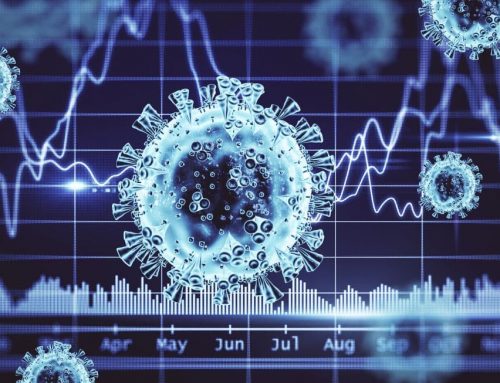It’s been known for a while that it’s been possible to recover viral genetic material from the poop of people with COVID-19. Could this be used to track and quell outbreaks?
Fast and accurate tests for COVID-19 remain challenging; I’ve written about the main methods before and each has its strengths and weaknesses.
But it’s been known for a while that many people who have COVID egest viral material in their stool. Or, put another way, you can find viral RNA their poo if you’ve a mind to look. The presence of viral RNA is not reliable enough to have much use as a diagnostic test at an individual level because not everyone who gets infected poops out the virus (or, more accurately, its debris) but there has been talk of testing sewage at a community level to track the spread of the disease. Trials have been conducted in a number of countries but a recent one shows you can do more than just track outbreaks.
Can you predict outbreaks with poop?
Yes. And the point is testing sewage for evidence of the virus is not just accurate, it’s predictive. In a fascinating study just out of Yale the researchers found:
Going through the motions...
The process is very simple. A small sample of raw sewage is analysed using RT-qPCR in a laboratory. It’s the same way throat swabs are analysed currently. The test doesn’t detect the virus itself – the chances of intact virions surviving in sewage are pretty much zero – the test is looking for the molecular fingerprint of COVID – genetic material specific to the virus.
We already knew wastewater in Milan contained viral RNA at the same time community transmission of COVID-19 was confirmed and similar findings were made in Valencia. But this study brings a bit more to the party.
Is this a gamechanger?
It could be. The cool thing is the Yale study shows predictive value. I’ve already looked at the biology of relaxing ‘lockdowns’ and the likelihood further will be needed on a regional / local / community level as cases rise and fall.
This sort of testing could proactively inform decisions to implement or relax public health interventions by tracking outbreak dynamics at a community level – and far more accurately than the ‘apps’ currently being trialled.
[And I can’t help but observe that many people made political comments on that post about the biology of lockdowns without realising viruses really don’t give a rat’s arse about your politics, you’re just another host, and also that those furiously Tweeting about privacy issues arising from being tracked by an app are mostly doing it from the tracking devices they’ve carried in their pockets for bleedin’ years…]
Can COVID spread via poop?
The primary route of transmission is respiratory droplets and close person-to-person contact.
Yes, there have been reports of GI symptoms. Plus SARS-CoV-2 uses ACE2 as a receptor, and ACE2 mRNA is highly expressed in the GI tract. But the precise mechanisms by which SARS-CoV-2 interacts with the GI tract remain occult.
There have been a handful of reports of viable virus being recovered from patient stool samples and more showing recovery of viral RNA (BIG difference) – but these reports are based on small numbers, prevalence in stool specimens has varied widely and there are methodological inconsistencies. Which is unsurprising – these are case reports of patients treated on the frontline during a pandemic and not formally designed research studies.
Despite looking quite hard there’s no real evidence this virus spreads via the faeco-oral (‘turd to tongue’) route. And the notion it could remain viable in sewage and get into potable water really is a non-starter.





Johnny Turd – what’s not to like?
I done heard tell you can get an idea of the popularity of sweetcorn at the same time.
What a load of Crap !
Bs
Stephen Stuart is that the Bovine Strain?
Thinks
Well since lockdown was eased, pretty sure there’s a shitstorm coming anyway…
Well i will be one who will make sure thiese people are held to account.
Make sure to keep adding your voice
What a load of shit
No surprise, I’ve been telling folks the whole Corona scam is a lot of shite since it began.
😂😂you people are clutching at straws jeez you guys will reap what you sew, opportunistic scum bags
Oh please it’s a harmless virus as stated by the government.. flu kills far more,, get a life
Debra Ann true that
Yes flu kills more. If you die of Covid you are still dead
Maira Escobar it’s all fear porn now.. and a money making machine
FFS here we go again. 🤣
I just tracked some shit on this post. And your full of it.
Dude my tooth hurts,I wE n pain,I cracked up laughing,cotton balls flew out,that was good,lmassoff,every1/laughed!110%/zillions of likes,laughing from TX
Melody Wix. That was Texas humor! East Tx
What are they going to come up with next.
GTFOH
Shit again
If that is your thing go ahead, I do not hold on to my shit
https://off-guardian.org/2020/05/31/its-all-bullsht-3-leaks-that-sink-the-covid-narrative/?fbclid=IwAR2e42qMsBo19S-EFHfLT90iG2VpWHcjKDQzJr4UYDKtJnTiZAAQ6HTmC7M&__cf_chl_jschl_tk__=e71036f54dbd894181a017182ceb5434e18b7d11-1591084615-0-AY-wU4w-i5gPBpzboYWbfwVKBfiAab3-U4x9Y6cfXdhjKwHyB_p-CBe2aPyKRUb9RGAFt6DxlwRwy39aQh2O3IOHzwBxARks4ZdgsMdkKNCdcwyb65atFmfBy4tk79yGMwNzpwP0BdKryEvcbwHA1t6gPmPxYFHAgf_9jijzgWSfCyFTXC4x5w2fQzZjI0W_3GweaymPceUPmdWqG9Cf1E_fVbPKbtMf5q4kPkhXe4c3etOTY5D_eu1ZlNjEaoBsLdLS8kHCJ19KZ2DLMxUZpeyJggM6wz1XTuYxZ-dgbC0HICEKKA82mcYtGxq-jcHVIns3-u-2KIPcvd1vtH_Ct9TvBJPyLKQJsbJjr6tHjzUVTU3LMwJCC-cqLMquQULb22PJZ-6q2SukyDH4yuNm_d_dIC-5vs9Ll6bn5wqb8hD7HP3HoSY44KvoWq2piWU0W19oCSkZrO-G8K-CPwYAHdE
I sure there’s a comeback about telling you where you stick it… ;)
Wtf…. Desperate measures…..
WHAT THE HECK!!!!
TOTAL BULL SHIT!!!!🤬
Dorothy Martin maybe that too
Ya never know these days
Ewww
Read of this idea earlier. Makes sense if accurate.
Retard shit
Nope
Wot ever fuckin next there’s some rate SHIT goin around !!
The Democrats want to track you for a new communist world. You can take your tracking lying bs and stick it.
This article reeks of bullshit and human shit
Taking the piss
Can we please get an update on the papaya fruit that is infected with covid? Did it make a full recovery?
It is a crappy job, but someone has to do it?
Bull shit. Check Inslee’s toilet it full of shit just like he is
thinkng your tests are out of date, the young decided to call your bluff and off they went to London yesterday.
Shirley
Ffs !!
By sewerage! Track the government then. 😂😃😁
🔔🔔DUNG DUNG DUNG….🔔🔔
AND WE HAVE A WINNER
CONGRATULATIONS
OH shit…
did I say dung dung dung?
Oh silly me😂😂😂😂😂
Hey! yea you! in THE next stall over….
have ya got a square to spare?
😂😂😂😂😂😂😂😂😂